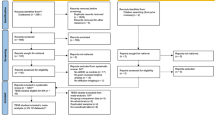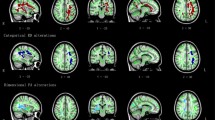Abstract
Evaluation of myelin content is crucial for attention-deficit/hyperactivity disorder (ADHD). To estimate myelin content in ADHD based on synthetic MRI–based method and compare it with established diffusion tensor imaging (DTI) method. Fifth-nine ADHD and fifty typically developing (TD) children were recruited. Global and regional myelin content (myelin volume fraction [MVF] and myelin volume [MYV]) were assessed using SyMRI and compared with DTI metrics (fractional anisotropy and mean/radial/axial diffusivity). The relationship between significant MRI parameters and clinical variables were assessed in ADHD. No between-group differences of whole-brain myelin content were found. Compared to TDs, ADHD showed higher mean MVF in bilateral internal capsule, external capsule, corona radiata, and corpus callosum, as well as in left tapetum, left superior fronto-occipital fascicular, and right cingulum (all PFDR-corrected < 0.05). Increased MYV were found in similar regions. Abnormalities of DTI metrics were mainly in bilateral corticospinal tract. Besides, MVF in right retro lenticular part of internal capsule was negatively correlated with cancellation test scores (r = – 0.41, P = 0.002), and MYV in right posterior limb of internal capsule (r = 0.377, P = 0.040) and left superior corona radiata (r = 0.375, P = 0.041) were positively correlated with cancellation test scores in ADHD. Increased myelin content underscored the important pathway of frontostriatal tract, posterior thalamic radiation, and corpus callosum underlying ADHD, which reinforced the insights into myelin quantification and its potential role in pathophysiological mechanism and disease diagnosis. Prospectively registered trials number: ChiCTR2100048109; date: 2021–07.




Similar content being viewed by others
Data availability
Data generated or analyzed during the study are available from the corresponding author by request.
Abbreviations
- ADHD:
-
Attention-deficit/hyperactivity disorder
- SyMRI:
-
Synthetic magnetic resonance imaging
- DTI:
-
Diffusion tensor imaging
- TD:
-
Typically developing
- MVF:
-
Myelin volume fraction
- MYV:
-
Myelin volume
- WM:
-
White matter
- CC:
-
Corpus callosum
- CG:
-
Cingulum
- FA:
-
Fractional anisotropy
- MD:
-
Mean diffusivity
- RD:
-
Radiate diffusivity
- AD:
-
Axial diffusivity
- PD:
-
Proton density
- PLIC:
-
Posterior limb of internal capsule
- RLIC:
-
Retro lenticular part of internal capsule
- ACR:
-
Anterior corona radiate
- SCR:
-
Superior corona radiate
- EC:
-
External capsule
- ALIC:
-
Anterior limb of internal capsule
- GCC:
-
Genu of corpus callosum
- SFOF:
-
Superior fronto-occipital fascicular
- CST:
-
Corticospinal tract
References
Polanczyk GV, Willcutt EG, Salum GA, Kieling C, Rohde LA (2014) ADHD prevalence estimates across three decades: an updated systematic review and meta-regression analysis. Int J Epidemiol 43:434–442
Connaughton M, Whelan R, O’Hanlon E, McGrath J (2022) White matter microstructure in children and adolescents with ADHD. Neuroimage Clin 33:102957
van Ewijk H, Heslenfeld DJ, Zwiers MP et al (2014) Different mechanisms of white matter abnormalities in attention-deficit/hyperactivity disorder: a diffusion tensor imaging study. J Am Acad Child Adolesc Psychiatry 53:790-799.e793
Cao Q, Sun L, Gong G et al (2010) The macrostructural and microstructural abnormalities of corpus callosum in children with attention deficit/hyperactivity disorder: a combined morphometric and diffusion tensor MRI study. Brain Res 1310:172–180
Shaw P, Sudre G, Wharton A, Weingart D, Sharp W, Sarlls J (2015) White matter microstructure and the variable adult outcome of childhood attention deficit hyperactivity disorder. Neuropsychopharmacology 40:746–754
Beaulieu C (2002) The basis of anisotropic water diffusion in the nervous system—a technical review. NMR Biomed 15:435–455
Wu ZM, Bralten J, Cao QJ et al (2017) White matter microstructural alterations in children with ADHD: categorical and dimensional perspectives. Neuropsychopharmacology 42:572–580
de Hoz L, Simons M (2015) The emerging functions of oligodendrocytes in regulating neuronal network behaviour. BioEssays 37:60–69
Grydeland H, Walhovd KB, Tamnes CK, Westlye LT, Fjell AM (2013) Intracortical myelin links with performance variability across the human lifespan: results from T1- and T2-weighted MRI myelin mapping and diffusion tensor imaging. J Neurosci 33:18618–18630
Zhang J, Kolind SH, Laule C, MacKay AL (2015) How does magnetization transfer influence mcDESPOT results? Magn Reson Med 74:1327–1335
Schmierer K, Scaravilli F, Altmann DR, Barker GJ, Miller DH (2004) Magnetization transfer ratio and myelin in postmortem multiple sclerosis brain. Ann Neurol 56:407–415
Hagiwara A, Warntjes M, Hori M et al (2017) SyMRI of the Brain: rapid quantification of relaxation rates and proton density, with synthetic MRI, automatic brain segmentation, and myelin measurement. Invest Radiol 52:647–657
Hagiwara A, Hori M, Yokoyama K et al (2017) Utility of a multiparametric quantitative MRI model that assesses myelin and edema for evaluating plaques, periplaque white matter, and normal-appearing white matter in patients with multiple sclerosis: a feasibility study. AJNR Am J Neuroradiol 38:237–242
Chen Y, Su S, Dai Y et al (2021) Brain volumetric measurements in children with attention deficit hyperactivity disorder: a comparative study between synthetic and conventional magnetic resonance imaging. Front Neurosci 15:711528
Yoo RE, Choi SH, Youn SW et al (2022) myelin content in mild traumatic brain injury patients with post-concussion syndrome: quantitative assessment with a multidynamic multiecho sequence. Korean J Radiol 23:226–236
Liu L, Cheng J, Su Y et al (2018) Deficiency of sustained attention in adhd and its potential genetic contributor MAOA. J Atten Disord 22:878–885
Ashburner J, Friston KJ (2005) Unified segmentation. Neuroimage 26:839–851
Rajapakse JC, Giedd JN, Rapoport JL (1997) Statistical approach to segmentation of single-channel cerebral MR images. IEEE Trans Med Imaging 16:176–186
Chiang HL, Chen YJ, Lo YC, Tseng WY, Gau SS (2015) Altered white matter tract property related to impaired focused attention, sustained attention, cognitive impulsivity and vigilance in attention-deficit/hyperactivity disorder. J Psychiatry Neurosci 40:325–335
Gau SS, Tseng WL, Tseng WY, Wu YH, Lo YC (2015) Association between microstructural integrity of frontostriatal tracts and school functioning: ADHD symptoms and executive function as mediators. Psychol Med 45:529–543
Castellanos FX, Proal E (2012) Large-scale brain systems in ADHD: beyond the prefrontal-striatal model. Trends Cogn Sci 16:17–26
Nazari MA, Berquin P, Missonnier P et al (2010) Visual sensory processing deficit in the occipital region in children with attention-deficit/hyperactivity disorder as revealed by event-related potentials during cued continuous performance test. Neurophysiol Clin 40:137–149
Sherbondy AJ, Dougherty RF, Napel S, Wandell BA (2008) Identifying the human optic radiation using diffusion imaging and fiber tractography. J Vis 8(12):11–11
McNally MA, Crocetti D, Mahone EM, Denckla MB, Suskauer SJ, Mostofsky SH (2010) Corpus callosum segment circumference is associated with response control in children with attention-deficit hyperactivity disorder (ADHD). J Child Neurol 25:453–462
Wakana S, Jiang H, Nagae-Poetscher LM, van Zijl PC, Mori S (2004) Fiber tract-based atlas of human white matter anatomy. Radiology 230:77–87
Meola A, Comert A, Yeh FC, Stefaneanu L, Fernandez-Miranda JC (2015) The controversial existence of the human superior fronto-occipital fasciculus: connectome-based tractographic study with microdissection validation. Hum Brain Mapp 36:4964–4971
Kumpulainen V, Merisaari H, Copeland A et al (2022) Effect of number of diffusion-encoding directions in diffusion metrics of 5-year-olds using tract-based spatial statistical analysis. Eur J Neurosci 56:4843–4868
Svatkova A, Nestrasil I, Rudser K, Goldenring Fine J, Bledsoe J, Semrud-Clikeman M (2016) Unique white matter microstructural patterns in ADHD presentations-a diffusion tensor imaging study. Hum Brain Mapp 37:3323–3336
Bouziane C, Caan MWA, Tamminga HGH et al (2018) ADHD and maturation of brain white matter: a DTI study in medication naive children and adults. Neuroimage Clin 17:53–59
Chen L, Hu X, Ouyang L et al (2016) A systematic review and meta-analysis of tract-based spatial statistics studies regarding attention-deficit/hyperactivity disorder. Neurosci Biobehav Rev 68:838–847
Overmeyer S, Bullmore ET, Suckling J et al (2001) Distributed grey and white matter deficits in hyperkinetic disorder: MRI evidence for anatomical abnormality in an attentional network. Psychol Med 31:1425–1435
McAlonan GM, Cheung V, Cheung C et al (2007) Mapping brain structure in attention deficit-hyperactivity disorder: a voxel-based MRI study of regional grey and white matter volume. Psychiatry Res 154:171–180
Neniskyte U, Gross CT (2017) Errant gardeners: glial-cell-dependent synaptic pruning and neurodevelopmental disorders. Nat Rev Neurosci 18:658–670
Gatto CL, Broadie K (2010) Genetic controls balancing excitatory and inhibitory synaptogenesis in neurodevelopmental disorder models. Front Synaptic Neurosci 2:4
Bethlehem RAI, Romero-Garcia R, Mak E, Bullmore ET, Baron-Cohen S (2017) Structural covariance networks in children with autism or ADHD. Cereb Cortex 27:4267–4276
Tamm L, Barnea-Goraly N, Reiss AL (2012) Diffusion tensor imaging reveals white matter abnormalities in attention-deficit/hyperactivity disorder. Psychiatry Res 202:150–154
Silk TJ, Vance A, Rinehart N, Bradshaw JL, Cunnington R (2009) White-matter abnormalities in attention deficit hyperactivity disorder: a diffusion tensor imaging study. Hum Brain Mapp 30:2757–2765
McAllister A, Leach J, West H, Jones B, Zhang B, Serai S (2017) Quantitative synthetic MRI in children: normative intracranial tissue segmentation values during development. AJNR Am J Neuroradiol 38:2364–2372
Phan TV, Smeets D, Talcott JB, Vandermosten M (2018) Processing of structural neuroimaging data in young children: Bridging the gap between current practice and state-of-the-art methods. Dev Cogn Neurosci 33:206–223
Wilke M, Holland SK, Altaye M, Gaser C (2008) Template-O-matic: a toolbox for creating customized pediatric templates. Neuroimage 41:903–913
Acknowledgements
We would like to thank the participants and their families and the staff at the MRI at our center for all their help and support.
Funding
This work was supported by the Natural Science Fund Youth Science Fund Project of China [grant number 82001439] and the Natural Science Fund Project of Guangdong Province [grant numbers 2022A1515011910].
Author information
Authors and Affiliations
Contributions
Liping Lin, Yingqian Chen, Yan Dai, Zhiyun Yang, and Shu Su wrote the main manuscript text and Zi Yan, Mengsha Zou, Qin Zhou, Long Qian, and Wei Cui prepared figures 1-4. Meina Liu and Hongyu Zhang prepared table 1-2. All authors reviewed the manuscript.
Corresponding authors
Ethics declarations
Conflict of interest
The authors of this manuscript declare no relationships with any companies whose products or services may be related to the subject matter of the article.
Ethics approval and consent to participate
This study was approved by the institutional review board of the First Affiliated Hospital of Sun Yat-Sen University (No. [2019]328). Written informed consent was obtained from the guardians of all the subjects and their guardians in this study.
Supplementary Information
Below is the link to the electronic supplementary material.
Rights and permissions
Springer Nature or its licensor (e.g. a society or other partner) holds exclusive rights to this article under a publishing agreement with the author(s) or other rightsholder(s); author self-archiving of the accepted manuscript version of this article is solely governed by the terms of such publishing agreement and applicable law.
About this article
Cite this article
Lin, L., Chen, Y., Dai, Y. et al. Quantification of myelination in children with attention-deficit/hyperactivity disorder: a comparative assessment with synthetic MRI and DTI. Eur Child Adolesc Psychiatry (2023). https://doi.org/10.1007/s00787-023-02297-3
Received:
Accepted:
Published:
DOI: https://doi.org/10.1007/s00787-023-02297-3




